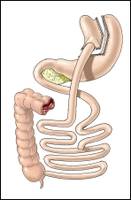Obesity Centre
Gastric Bypass
Roux-en-Y Gastric Bypass
Bypass means « go round ». Gastric refers to « stomach ».
Making a gastric bypass consists of modifying the digestive canal so the food bypasses the stomach.
The surgeon divides the stomach into a very small upper pouch, directly under the oesophagus, and a lower part, the remainder of the organ, which is disabled.
The upper part is reconnected to the small intestine.
The food passes almost immediately from the oesophagus to the intestine, without the first stage of digestion that is normally performed by the stomach.
The acronym RYGB comes from "Roux-en-Y" Gastric Bypass because the new connection of the intestine to the stomach pouch has the shape of a Y as it was described by a surgeon with the name of Roux.
The intake capacity is reduced because the first pouch is very small. Thus the operation is restrictive.
As food is not exposed to gastric juices, the operation also produces a malabsorptive effect, which means taking vitamin supplements on a permanent basis. The malabsorptive effect can be increased by extending the intestinal Y-shaped segment (distal gastric bypass).
On the other hand, the small intestine does not tolerate well the direct arrival of sweet food : its consumption often brings about a dumping syndrome, an uncomfortable reaction and painful abdominal spasms.

